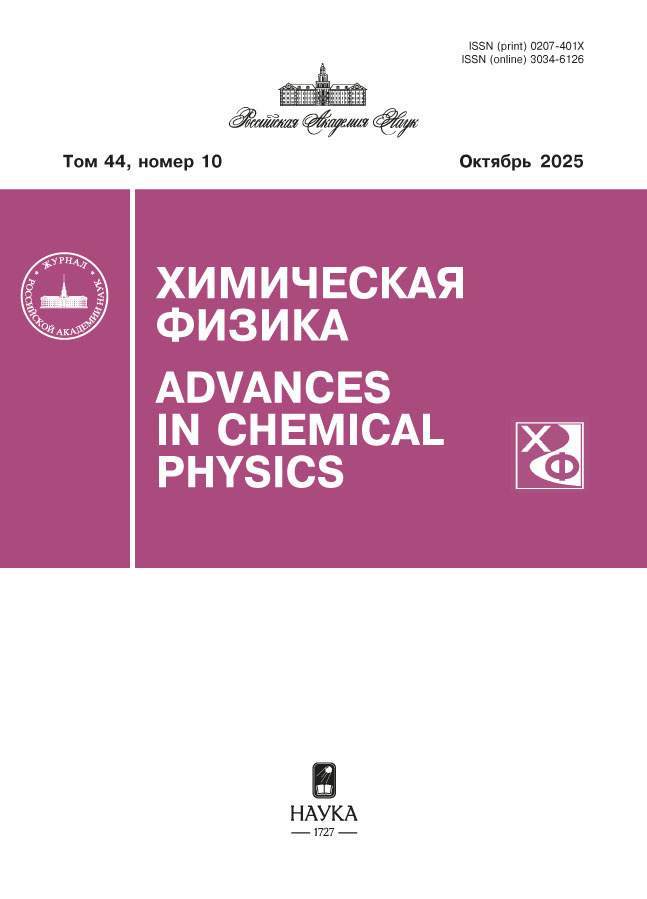The Initiation Mechanism of the Isoolefin Oligomerization Reaction in the Presence of Ethylaluminum Dichloride – Protonodonor Complex Catalysts
- Authors: Zaikov G.E.1, Artsis M.I.1, Babkin V.A.2, Andreev D.S.2, Ignatov A.V.2, Zakharov D.S.2, Vovko V.V.3, Belousova V.S.4
-
Affiliations:
- Emanuel Institute of Biochemical Physics, Russian Academy of Sciences
- Sebryakovo Branch of the Volgograd State Technical University
- Volgograd State Technical University
- Sechenov First Moscow State Medical University
- Issue: Vol 43, No 3 (2024)
- Pages: 35-46
- Section: Kinetics and mechanism of chemical reactions, catalysis
- URL: https://cardiosomatics.orscience.ru/0207-401X/article/view/674971
- DOI: https://doi.org/10.31857/S0207401X24030045
- EDN: https://elibrary.ru/VGNGKR
- ID: 674971
Cite item
Abstract
The mechanism of isoolefins initiation in the presence of ethylaluminum dichloride – proton donor (water, phenol, hydrochloric acid) complex catalysts has been studied by ab initio HF.3.21G. The energetics of these reactions was estimated, the values of its activation energy and thermal effects were obtained. It was found that among the studied catalysts, an increase in the activation energy of the reaction of initiation of oligomerization of isoolefins contributes to an increase in the selectivity of the process.
Full Text
About the authors
G. E. Zaikov
Emanuel Institute of Biochemical Physics, Russian Academy of Sciences
Email: chembio@sky.chph.ras.ru
Russian Federation, Moscow
M. I. Artsis
Emanuel Institute of Biochemical Physics, Russian Academy of Sciences
Author for correspondence.
Email: chembio@sky.chph.ras.ru
Russian Federation, Moscow
V. A. Babkin
Sebryakovo Branch of the Volgograd State Technical University
Email: chembio@sky.chph.ras.ru
Russian Federation, Mikhailovka
D. S. Andreev
Sebryakovo Branch of the Volgograd State Technical University
Email: chembio@sky.chph.ras.ru
Russian Federation, Mikhailovka
A. V. Ignatov
Sebryakovo Branch of the Volgograd State Technical University
Email: chembio@sky.chph.ras.ru
Russian Federation, Mikhailovka
D. S. Zakharov
Sebryakovo Branch of the Volgograd State Technical University
Email: chembio@sky.chph.ras.ru
Russian Federation, Mikhailovka
V. V. Vovko
Volgograd State Technical University
Email: chembio@sky.chph.ras.ru
Russian Federation, Volgograd
V. S. Belousova
Sechenov First Moscow State Medical University
Email: chembio@sky.chph.ras.ru
Russian Federation, Moscow
References
- Zaikov G.E., Artsis M.I., Andreev D.S., Ignatov A.V. // Russian Journal of Physical Chemistry B. 2022. V. 16. № 4. P. 606–614.
- Babkin V.A., Zaikov G.E., Minsker K.S. // Ufa: Gilem Publ., 1996. 182 p.
- Kol’tsov N. I. // Russian Journal of Physical Chemistry B. 2020. V. 14. № 5. P. 765–772. https://doi.org/10.1134/S1990793120050061.
- Tereza A.M., Agafonov G.L., Anderzhanov E.K., Medvedev S.P., Khomik S.V., Petrov S.K., Chernyshov M.V. // Russian Journal of Physical Chemistry B. 2020. V. 14. № 4. P. 654–659. https://doi.org/10.1134/S1990793120040247.
- Tarasov D.N., Tiger R.P. // Russian Journal of Physical Chemistry B. 2019. V. 13. No 3. P. 478–485. https://doi.org/10.1134/S1990793119030138.
- Volokhov V.M., Zyubina T.S., Volokhov A.V., Amosova E.S., Varlamov D.A., Lempert D.B., Yanovskii L.S. // Russian Journal of Physical Chemistry B. 2021. V. 15. № 1. P. 12–24. https://doi.org/10.1134/S1990793121010127
- Tsirelson V.G. // Moscow: Binom, 2010. 422 p.
- Babkin V.A., Andreev D.S., Ignatov A.V., Lisina L.M., Belousova V.S., Fomichev V.T., Prochukhan K.Yu., Artsis M.I., Zaikov G.E. // Oxidation Communications. 2019. V. 42. № 1. P. 56–62.
- Babkin V.A., Andreev D.S., Ignatov A.V., Belousova V.S., Fomichev V.T., Artsis M.I., Zaikov G.E. // Oxidation Communications. 2020. V. 43. № 1. P. 24–30.
- Babkin V.A., Andreev D.S., Ignatov A.V., Belousova V.S., Fomichev V.T., Akchurin T.K., Artsis M.I., Zaikov G.E. // Oxidation Communications. 2020. V. 43. № 2. P. 171–176.
- Granovsky A.A. 2013. http://classic.chem.msu.su/gran/firefly/index.html
- Schmidt M.W., Baldridge K.K., Boatz J.A., Elbert S.T., Gordon M.S., Jensen J.H., Koseki S., Matsunaga N., Nguyen K.A., Su S.J., Windus T.L., Dupuis M., Montgomery J.A. // J.Comput.Chem. 1993. V. 14. P. 1347–1363.
- Bode B.M., Gordon M.S. // Journal of Molecular Graphics. 1998. No. 16. P. 133–138.
- Pasynkiewicz S., Boleslawski M., Sadownik A. // Journal of Organometallic Chemistry. 1976. V. 113. № 4. P. 303–309.
Supplementary files




















